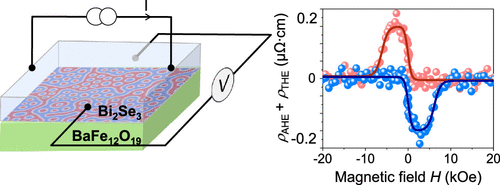当前位置:
X-MOL 学术
›
Nano Lett.
›
论文详情
Our official English website, www.x-mol.net, welcomes your
feedback! (Note: you will need to create a separate account there.)
Topological Hall Effect in a Topological Insulator Interfaced with a Magnetic Insulator
Nano Letters ( IF 9.6 ) Pub Date : 2020-12-23 , DOI: 10.1021/acs.nanolett.0c03195 Peng Li 1 , Jinjun Ding 1 , Steven S.-L. Zhang 2, 3 , James Kally 4 , Timothy Pillsbury 4 , Olle G. Heinonen 2 , Gaurab Rimal 5 , Chong Bi 6 , August DeMann 1 , Stuart B. Field 1 , Weigang Wang 6 , Jinke Tang 5 , Jidong Samuel Jiang 2 , Axel Hoffmann 2, 7 , Nitin Samarth 4 , Mingzhong Wu 1
Nano Letters ( IF 9.6 ) Pub Date : 2020-12-23 , DOI: 10.1021/acs.nanolett.0c03195 Peng Li 1 , Jinjun Ding 1 , Steven S.-L. Zhang 2, 3 , James Kally 4 , Timothy Pillsbury 4 , Olle G. Heinonen 2 , Gaurab Rimal 5 , Chong Bi 6 , August DeMann 1 , Stuart B. Field 1 , Weigang Wang 6 , Jinke Tang 5 , Jidong Samuel Jiang 2 , Axel Hoffmann 2, 7 , Nitin Samarth 4 , Mingzhong Wu 1
Affiliation

|
A topological insulator (TI) interfaced with a magnetic insulator (MI) may host an anomalous Hall effect (AHE), a quantum AHE, and a topological Hall effect (THE). Recent studies, however, suggest that coexisting magnetic phases in TI/MI heterostructures may result in an AHE-associated response that resembles a THE but in fact is not. This Letter reports a genuine THE in a TI/MI structure that has only one magnetic phase. The structure shows a THE in the temperature range of T = 2–3 K and an AHE at T = 80–300 K. Over T = 3–80 K, the two effects coexist but show opposite temperature dependencies. Control measurements, calculations, and simulations together suggest that the observed THE originates from skyrmions, rather than the coexistence of two AHE responses. The skyrmions are formed due to a Dzyaloshinskii–Moriya interaction (DMI) at the interface; the DMI strength estimated is substantially higher than that in heavy metal-based systems.
中文翻译:

与电磁绝缘子连接的拓扑绝缘子中的拓扑霍尔效应
与磁绝缘体(MI)交界的拓扑绝缘体(TI)可以承载异常霍尔效应(AHE),量子AHE和拓扑霍尔效应(THE)。然而,最近的研究表明,TI / MI异质结构中共存的磁相可能导致与THE相似的AHE相关反应,但实际上并非如此。这封信报道了只有一个磁相的TI / MI结构中的真实THE。结构示出了中相应的温度范围内的Ť = 2-3 K和在AHE Ť = 80-300 K.超过Ť= 3–80 K,这两种效应共存,但显示出相反的温度依赖性。对照测量,计算和模拟一起表明,观察到的THE来自天体离子,而不是两个AHE反应的共存。由于在界面处发生了Dzyaloshinskii-Moriya相互作用(DMI),形成了天rm。DMI强度估计值大大高于重金属基系统。
更新日期:2021-01-13
中文翻译:

与电磁绝缘子连接的拓扑绝缘子中的拓扑霍尔效应
与磁绝缘体(MI)交界的拓扑绝缘体(TI)可以承载异常霍尔效应(AHE),量子AHE和拓扑霍尔效应(THE)。然而,最近的研究表明,TI / MI异质结构中共存的磁相可能导致与THE相似的AHE相关反应,但实际上并非如此。这封信报道了只有一个磁相的TI / MI结构中的真实THE。结构示出了中相应的温度范围内的Ť = 2-3 K和在AHE Ť = 80-300 K.超过Ť= 3–80 K,这两种效应共存,但显示出相反的温度依赖性。对照测量,计算和模拟一起表明,观察到的THE来自天体离子,而不是两个AHE反应的共存。由于在界面处发生了Dzyaloshinskii-Moriya相互作用(DMI),形成了天rm。DMI强度估计值大大高于重金属基系统。









































 京公网安备 11010802027423号
京公网安备 11010802027423号